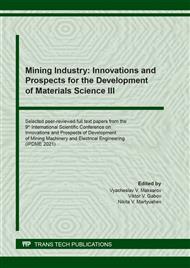[1]
O.S. Vasiliev, S.G Gorny, Technology of creating surface microstructures on sheet materials using fiber laser, Metalworking 3(93) (2016) 20-25.
Google Scholar
[2]
V. Biryukov, Laser technology in mechanical engineering, Photonics 2 (2013) 46-53.
Google Scholar
[3]
A.G. Ignatov, Laser technologies: problems and solutions, Rhythm Engineering 6 (2018) 30-33.
Google Scholar
[4]
A.M. Schipachev, The choice of an optimal technological process for mechanical treatment of machine components based on structural models, IOP Conference Series: Earth and Environmental Science 1(378) (2019).
DOI: 10.1088/1755-1315/378/1/012070
Google Scholar
[5]
J.R Ai Qun Wang, J.М. Li, Y.S. Wu, An adaptive image binarization method for laser direct marking data matrix symbols on metal surface, Applied Mechanics and Materials 401-403 (2013) 1319-1323.
DOI: 10.4028/www.scientific.net/amm.401-403.1319
Google Scholar
[6]
E.I. Pryakhin, E.V. Larionova, E.A. Zakharenko, Creating and approbation of the hardware and software complex for information fields application on the surface of products, J. of Mining Institute 209 (2014) 234-238.
Google Scholar
[7]
V.P. Veiko, V.K. Luong, G.V. Odintsova, V.V. Romanov, R.M. Yatsuk, Optimization of color laser marking technology of metals for industrial applications, VII International Conference on Photonics and Information Optics: Collection of scientific papers (2018) 468.
Google Scholar
[8]
J. Camillo, Lasers for marking parts: When the application calls for a high volume of parts to be permanently marked, a laser-based system is the best choice, Assembly 59(8) (2016).
Google Scholar
[9]
P.M. Kuznetsov, V.A. Fedorov, Features of thermocapillary wave excitation by laser radiation on the surface of the irradiated metal target, Perspective materials in engineering and construction (PMTS-2013): collection of papers (2013) 215-217.
Google Scholar
[10]
O.Y. Ganzulenko, A.P. Petkova, Laser marking technology of serial products from metal and polymeric materials for their accounting and identification, Metalworking 1(79) (2014) 21-26.
Google Scholar
[11]
D.A. Konchus, A.V. Sivenkov, A.V. Mikhailov, E.I. Pryakhin, Laser marking influence on corrosion resistance of stainless steel, St. Petersburg Polytechnic University Journal 1 (2020) 62-75.
Google Scholar
[12]
O.S. Yulmetova, M.A. Tumanova, Laser marking of contrast images for optical read-out systems, IOP Conf. Series: Journal of Physics 917 (2017) 052007.
DOI: 10.1088/1742-6596/917/5/052007
Google Scholar
[13]
G. Odintsova, Y. Andreeva, A. Salminen, H. Roozbahani, V. Lan Cuong, R. Yatsuk, V. Golubeva, V. Romanov, V. Veiko, Investigation of production related impact on the optical properties of color laser marking, Journal of Materials Processing Technology 274 (2019) 116263.
DOI: 10.1016/j.jmatprotec.2019.116263
Google Scholar
[14]
O.Y. Ganzulenko, A.P. Petkova, Selection of alloying elements in steels for obtaining images full range of colors on the surface of the products by means of a pulsed laser radiation, J. of Mining Institute 209 (2014) 216-219.
Google Scholar
[15]
E.A. Zakharenko, E.I. Pryakhin, V.V. Romanov, et al., Development of the technology of NBC code formation on a metal surface by laser marking, Journal of Physics: Conference Series 1(1753) (2021).
DOI: 10.1088/1742-6596/1753/1/012003
Google Scholar
[16]
P.M. Kuznetsov, V.A. Fedorov, Features of relief formation on the surface of metals in the zone of laser irradiation, Tambov University Reports, Series: Natural and Technical Sciences. 4(20) (2015) 872-877.
Google Scholar
[17]
D.N. Antonov, A.A. Burtsev, O.Y. Butkovsky, Coloring of metal surfaces under the action of pulsed laser radiation, Journal of Technical Physics 84(10) (2014) 83-86.
Google Scholar
[18]
V.P. Veiko, S. Gorny, G.V. Odintsova, M.I. Patrov, K.V. Yudin, Formation of multicolor image on metal surface during its laser oxidation, Journal of Instrument Engineering 2(54) (2011) 47-52.
Google Scholar
[19]
D.A. Konchus, A.V. Sivenkov, The Formation of Contrasting Nanofilms on a Metal Surface for Bar Coding, KEM 854 (2020) 97-102.
DOI: 10.4028/www.scientific.net/kem.854.97
Google Scholar


